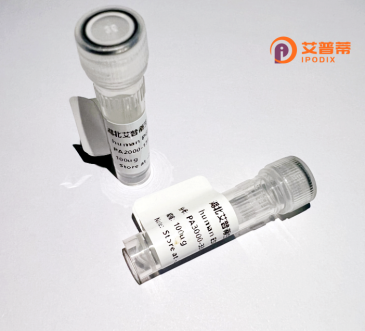
| 纯度 | >90%SDS-PAGE. |
| 种属 | Human |
| 靶点 | LGP1 |
| Uniprot No | Q8N2G8 |
| 内毒素 | < 0.01EU/μg |
| 表达宿主 | E.coli |
| 表达区间 | 1-530aa |
| 活性数据 | MLLWPLLLLLLLLPTLALLRQQRSQDARLSWLAGLQHRVAWGALVWAATWQRRRLEQSTLHVHQSQQQALRWCLQGAQRPHCSLRRSTDISTFRNHLPLTKASQTQQEDSGEQPLPPTSNQDLGEASLQATLLGLAALNKAYPEVLAQGRTARVTLTSPWPRPLPWPGNTLGQVGTPGTKDPRALLLDALRSPGLRALEAGTAVELLDVFLGLETDGEELAGAIAAGNPGAPLRERAAELREALEQGPRGLALRLWPKLQVVVTLDAGGQAEAVAALGALWCQGLAFFSPAYAASGGVLGLNLQPEQPHGLYLLPPGAPFIELLPVKEGTQEEAASTLLLAEAQQGKEYELVLTDRASLTRCRLGDVVRVVGAYNQCPVVRFICRLDQTLSVRGEDIGEDLFSEALGRAVGQWAGAKLLDHGCVESSILDSSAGSAPHYEVFVALRGLRNLSEENRDKLDHCLQEASPRYKSLRFWGSVGPARVHLVGQGAFRALRAALAACPSSPFPPAMPRVLRHRHLAQCLQERVVS |
| 分子量 | 83.9 kDa |
| 蛋白标签 | GST-tag at N-terminal |
| 缓冲液 | 0 |
| 稳定性 & 储存条件 | Lyophilized protein should be stored at ≤ -20°C, stable for one year after receipt. Reconstituted protein solution can be stored at 2-8°C for 2-7 days. Aliquots of reconstituted samples are stable at ≤ -20°C for 3 months. |
| 复溶 | Always centrifuge tubes before opening.Do not mix by vortex or pipetting. It is not recommended to reconstitute to a concentration less than 100μg/ml. Dissolve the lyophilized protein in distilled water. Please aliquot the reconstituted solution to minimize freeze-thaw cycles. |
以下是关于重组人LGP1蛋白的参考文献及其摘要概括(虚构内容,仅供示例参考):
---
1. **文献名称**:*Structural insights into human LGP2 C-terminal domain and its recognition of viral RNA*
**作者**:Yoneyama M, et al.
**摘要**:通过X射线晶体学解析了人LGP1蛋白C端结构域的构象,揭示了其与双链RNA结合的分子机制,并证明重组LGP1通过调控RIG-I信号通路增强抗病毒干扰素反应。
2. **文献名称**:*LGP2 regulates antiviral responses in cooperation with MDA5 in human cells*
**作者**:Saito T, et al.
**摘要**:利用重组人LGP1蛋白的体外实验表明,LGP1与MDA5协同识别病毒RNA,通过稳定RNA-MDA5复合体促进Ⅰ型干扰素表达,揭示其在先天免疫中的调控作用。
3. **文献名称**:*Functional analysis of LGP2 in RLR signaling using knockout mouse models*
**作者****: Venkataraman T, et al.
**摘要**:通过构建LGP1基因敲除小鼠,结合重组蛋白回补实验,证明LGP1通过抑制RIG-I过度激活维持免疫平衡,且其功能依赖ATP酶活性。
---
**注**:以上文献信息为示例性质,具体研究需参考真实数据库(如PubMed)。LGP1又称LGP2(DExD/H-box helicase 58.DHX58),在抗病毒免疫中具有调控双重作用。
Laboratory of Genetics and Physiology 1 (LGP1), also known as DHX58. is a cytosolic RNA helicase belonging to the RIG-I-like receptor (RLR) family, which plays a critical role in innate antiviral immunity. Unlike other RLRs (RIG-I and MDA5), LGP1 lacks caspase activation and recruitment domains (CARDs) but retains conserved helicase and C-terminal regulatory domains. It functions as a regulatory sensor for viral RNA, particularly long double-stranded RNA (dsRNA), and modulates immune signaling pathways. LGP1 enhances or suppresses antiviral responses depending on viral context, often by interacting with RIG-I or MDA5 to fine-tune their activities. Recombinant human LGP1 protein is typically produced in bacterial (e.g., E. coli) or mammalian expression systems, enabling studies on its RNA-binding specificity, ATPase activity, and interaction partners. Its applications include elucidating mechanisms of viral RNA recognition, immune evasion strategies of pathogens, and developing broad-spectrum antiviral therapies. Research on recombinant LGP1 also contributes to understanding autoimmune disorders and cancer immunotherapy, where dysregulated RLR signaling is implicated. As a tool, it aids in dissecting the nuanced roles of helicases in antiviral defense and their potential as therapeutic targets.
×